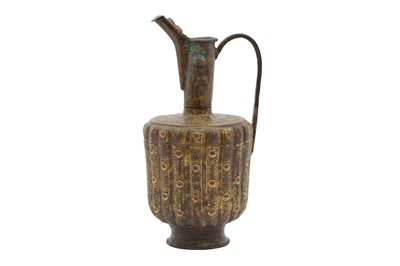31st Oct, 2023 11:00
Islamic Art - Property of a European Collector Part VI
A COPPER-INLAID BRASS EWER WITH LION AND LUNAR MOTIFS
Possibly Herat, Khorasan, Eastern Iran, ca. 1180 - 1220
A COPPER-INLAID BRASS EWER WITH LION AND LUNAR MOTIFS
Possibly Herat, Khorasan, Eastern Iran, ca. 1180 - 1220
Of wide cylindrical shape, with a tall fluted body resting on a splayed circular foot, rising to flat shoulders and a cylindrical neck with a high, beak-like spout pierced three times, and a slim curved handle on the side, the ribs of the gadrooned body decorated with vertical bands alternating Kufic inscriptions and vegetal scrollwork, all interspersed with copper-inlaid roundels with lunar symbols, the shoulders incised with a wide epigraphic band in Kufic script against a ground of vegetal sprays encased within two copper-inlaid lines, the base of the neck hammered in a multi-pointed star shape, the neck and spout worked in repoussé featuring two lions on the side and a recumbent lion on the top, 39cm high.
The 12th and early 13th centuries are considered by many the Golden Age of Medieval Iranian metalwork, and the Khurasan region was its epicentre and catalyst. In particular, Herat, an important urban trading centre that flourished under the Ghurids, became renowned for its high-quality silver and copper-inlaid metal vessels, usually made of bronze or brass. Differently from the workshops in the Western Seljuq regions catering exclusively to the nobility and ruling elite's needs, Herat metalwares were sold and exported by the merchant class to the emerging social cluster of learned, bourgeois customers, including more localised political eminences and religious authorities (Sheila R. Canby et al., Court and Cosmos: the Great Age of the Seljuqs, MET exhibition catalogue, 2016, cat. 85, p. 155).
Together with the use of colorful metal inlays, the Herat school distinguished itself as well for the introduction of animal and figural motifs achieved with the repoussé technique. Lions appear frequently on the neck and spout of ewers like ours, as evident in a number of exemplars including the well-known ewer in the Georgian National Museum, Tbilisi (19-2008:32), signed by the Herati maker Mahmud b. Muhammad al-Harawi and dated Sha'ban 577 AH (1181 - 1182 AD). The decorative combination of lions, or real animals, and planets, like the inlaid lunar roundels on the body of our ewer, is not a random one. For further comparison, please see two other late 12th-century ewers presenting the same combination of repoussé lions and inlaid / engraved lunar roundels in the Louvre Museum (inv. no. AA 176, published in A. Collinet, 2021, cat. 24, p. 176) and in the Khalili Collection of Islamic Art (inv. no. MTW 1549, published in J. M. Rogers, 2010, cat. 106, p. 98). Scholars have hypothesised a metaphorical link in this duo, meant to represent the connection between the material and spiritual worlds (Ibidem, p. 156). This would occasionally be reinforced by carefully selected auspicious poetic passages inscribed on the ewers' bodies. In this light, ewers like the present lot offered their owners and beholders more than just an aesthetically pleasing vessel, but a long-lasting and functional talismanic and apotropaic tool.
Dimensions: 39cm high
Sold for £9,375
Includes Buyer's Premium
Do you have an item similar to the item above? If so please click the link below to request a free online valuation through our website.








